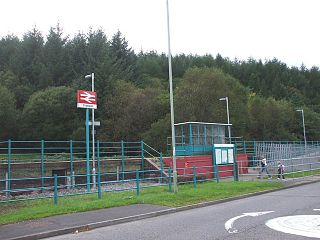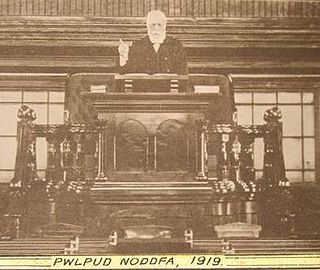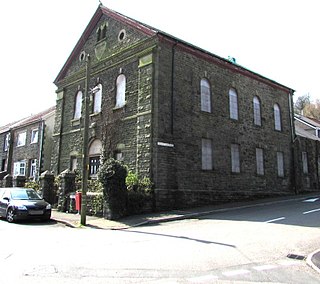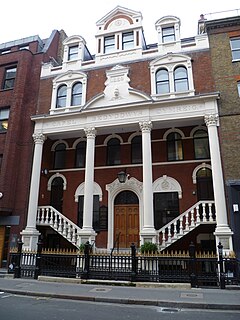
Aberdare is a town in the Cynon Valley area of Rhondda Cynon Taf, Wales, at the confluence of the Rivers Dare (Dâr) and Cynon. Aberdare has a population of 39,550. Aberdare is 4 miles (6 km) south-west of Merthyr Tydfil, 20 miles (32 km) north-west of Cardiff and 22 miles (35 km) east-north-east of Swansea. During the 19th century it became a thriving industrial settlement, which was also notable for the vitality of its cultural life and as an important publishing centre.

Treorchy is a village and community in Wales. Once a town, it retains the characteristics of a town. Situated in the county borough of Rhondda Cynon Taf in the Rhondda Fawr valley. Treorchy is also one of the 16 communities of the Rhondda. It includes the villages of Cwmparc and Ynyswen.

Rhondda, or the Rhondda Valley, is a former coalmining area in South Wales, previously in Glamorgan, now a local government district, of 16 communities around the River Rhondda. It embraces two valleys – the larger Rhondda Fawr valley and the smaller Rhondda Fach valley – so that the singular "Rhondda Valley" and the plural are both commonly used. In 2001, the Rhondda constituency of the National Assembly for Wales had a population of 72,443; while the National Office of Statistics counted the population as 59,602. Rhondda forms part of Rhondda Cynon Taf County Borough and of the South Wales Valleys. It is most noted for its historical coalmining industry, which peaked between 1840 and 1925. The valleys produced a strong Nonconformist movement manifest in the Baptist chapels that moulded Rhondda values in the 19th and early 20th centuries. It is also famous for male voice choirs and in sport and politics.

Cwm Rhondda, taken from the Welsh name for the Rhondda Valley, is a popular hymn tune written by John Hughes (1873–1932) in 1907.

Treorchy Male Choir, also known as Treorchy Male Voice Choir, is a choir based in Treorchy in the Rhondda Valley, Wales, United Kingdom.

Ynyswen is a village in the community of Treorchy, in the county borough of Rhondda Cynon Taf, Wales.

Calfaria Baptist Chapel, Aberdare, was one of the largest baptist churches in the South Wales Valleys and the oldest in the Aberdare valley. The chapel had an ornate interior, including a boarded ceiling with a deeply undercut rose, while the balcony balustrading had a cast iron front with an intricate foliage design. These features were common in the Welsh chapels of the late nineteenth century. The organ was installed in 1903 at a cost of £850. It was played for the last time in 2012 by Robert Nicholls, during a Radio Cymru broadcast shortly before the closure of the chapel.
The first election to the Glamorgan County Council were held on 17 January 1889. Results were announced over several days. They were followed by the 1892 election. The authority, by far the largest county in Wales in terms of population, was established by the 1888 Local Government Act. The county of Glamorgan was at this time becoming heavily industrialised although some areas such as the Vale of Glamorgan remained essentially rural.
Nebo, Ystrad Rhondda was the first Baptist chapel in the Rhondda Valleys. Founded in 1786, and known as Ynysfach, its first minister was one Thomas Edwards. The name was changed to Nebo in the early part of the nineteenth century.
Hebron, Ton Pentre was one of the largest Baptist churches in the Rhondda valleys during their industrial heyday. As membership increased the chapel was rebuilt in 1889 and a schoolroom added in 1908.

William Morris, widely known by his bardic name, Rhosynnog, was the minister of Noddfa Baptist Church, Treorchy, South Wales from soon after its formation in 1868 until his death.
Ynyslwyd Chapel, Aberdare was a Baptist chapel in Sunny Bank Place, located between Aberaman and Aberdare. It was formed as a branch of Calfaria, Aberdare.
Ebenezer, Trecynon is an Independent (Congregationalist) chapel in Ebenezer Street, Trecynon, Aberdare, Wales. It was one of the earliest Independent chapels in the Cynon Valley and remained an active place of worship until 2009.

Jerusalem, Ynysybwl was a Calvinistic Methodist chapel in Thompson Street, Ynysybwl, Glamorgan, Wales. Services at Jerusalem were conducted in the Welsh language.
Jerusalem, Penrhiwceiber was a Baptist chapel in Penrhiwceiber, Glamorgan, Wales. Services at Jerusalem were conducted in the Welsh language.

Bethania is an Independent chapel in Phillip Street, Mountain Ash, Glamorgan, Wales. Services at Bethania are conducted in the Welsh language.
Soar, Cwmaman was a Welsh Calvinistic Methodist chapel in Fforchaman Road, Cwmaman, Rhondda Cynon Taf, Wales.

The Welsh Church of Central London, also known as The Welsh Baptist Chapel is a Welsh Baptist church in Eastcastle Street, in the City of Westminster, London, England. The church building is a grade II listed building with Historic England on the National Heritage List for England. It currently performs Baptist services bilingually in English and in Welsh as well as hosting concerts following a merger of the Welsh Baptist church with two nearby Independent churches in 2006.

Capel Als is an Independent (Congregational) chapel in Llanelli, Carmarthenshire, Wales, It is regarded as one of the most significant religious buildings in Wales. Folk tradition suggested that the name refers to a woman named Alys (Alice) whose cottage stood where the chapel was built. However, another theory contends that the Welsh word als translates as rock, and there is a rock-face behind the chapel.
John Haydn Davies was a Welsh schoolmaster and conductor. His family lived in the Rhondda area, and he was introduced to music whilst attending Blaencwm Welsh Baptist Chapel. He was educated at Blaencwm Elementary School, before winning a scholarship to attend Tonypandy Grammar School. He then trained as a teacher at Caerleon College, and took up a position at Blaencwm Primary, Rhondda. As a young schoolmaster he became conductor of the Blaencwm Choral Society, and was so competent that he was invited to become assistant conductor of the Treorchy Male Choir. In 1946 he became the choir's principal conductor, and held the post until he retired in 1968. From 1960 he held the position of Headmaster of Brodringallt Primary in Ystrad, remaining there for the rest of his career.












